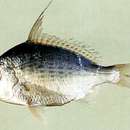Trophic Strategy
provided by Fishbase
Occur in inshore waters of the continental shelf (Ref. 75154). Primarily marine but enter fresh water (Ref.4967). Marine species that may enter lakes (Ref. 4323) and lower freshwater reaches of rivers (Ref. 12915). Juveniles are found in brackish mangrove estuaries and sometimes enter fresh water (Ref. 2847). Schooling species (Ref. 75154). Feed on small crustaceans, polychaetes and forams on sand or muddy-sand bottoms (Ref. 12915).
Morphology
provided by Fishbase
Dorsal spines (total): 9; Dorsal soft rays (total): 10 - 11; Anal spines: 2 - 3; Analsoft rays: 7 - 8
- Recorder
- Estelita Emily Capuli
Diagnostic Description
provided by Fishbase
Description: Body silvery with 7-10 and oval black spots in vertical series on upper half side. caudal fin large and forked deeply. Maxillary reaches beyond level of eye anterior edge. Body depth max 2.0-2.5 in SL. Scales above LL to middle dorsal spines 4.5-5.5. Dorsal fin 2nd spine filamentous and very long, 1.7-2.0 in SL; pectoral fins reaches beyond level of anal fin origin; caudal fin large and forked deeply. (Ref. 4967, 48635, 90102)
- Recorder
- Estelita Emily Capuli
Diseases and Parasites
provided by Fishbase
Heterophyopsis Infestation. Parasitic infestations (protozoa, worms, etc.)
Diseases and Parasites
provided by Fishbase
Procerovum Infestation 1. Parasitic infestations (protozoa, worms, etc.)
Diseases and Parasites
provided by Fishbase
Haplorchis Infestation 2. Parasitic infestations (protozoa, worms, etc.)
Diseases and Parasites
provided by Fishbase
Stictodora Infestation 1. Parasitic infestations (protozoa, worms, etc.)
Life Cycle
provided by Fishbase
Juveniles enter estuaries and mangrove areas at 1 cm SL and stay until they reach maturity, at which stage they move out to sea (Ref. 36558).
Migration
provided by Fishbase
Amphidromous. Refers to fishes that regularly migrate between freshwater and the sea (in both directions), but not for the purpose of breeding, as in anadromous and catadromous species. Sub-division of diadromous. Migrations should be cyclical and predictable and cover more than 100 km.Characteristic elements in amphidromy are: reproduction in fresh water, passage to sea by newly hatched larvae, a period of feeding and growing at sea usually a few months long, return to fresh water of well-grown juveniles, a further period of feeding and growing in fresh water, followed by reproduction there (Ref. 82692).
- Recorder
- Crispina B. Binohlan
Biology
provided by Fishbase
Adults are coastal inhabitants found on soft bottoms (Ref. 44894), over sandy substrate (Ref. 12693). Juveniles are found in brackish mangrove estuaries, sometimes enter fresh water (Ref. 2847, 44894), lakes (Ref. 4323), tidal creeks (Ref. 44894) and lower freshwater reaches of rivers (Ref. 12915). Feed on small crustaceans, polychaetes and forams on sand or muddy-sand bottoms (Ref. 12915), worms and insect larvae (Ref. 12693). Length at first reproduction was reported to be around 12 cm SL, for a population in a South African estuary (D. Woodland, pers.comm. 07/13). Salted or made into fish sauce.
- Recorder
- Crispina B. Binohlan
Importance
provided by Fishbase
fisheries: minor commercial; price category: medium; price reliability: questionable: based on ex-vessel price for species in this genus
- Recorder
- Crispina B. Binohlan
分布
provided by The Fish Database of Taiwan
分布於印度-西太平洋區,由非洲到日本及澳洲。台灣各地沙泥底質沿岸皆有分布。
利用
provided by The Fish Database of Taiwan
本種魚以手釣、圍網、拖網或流刺網均可捕獲,量不多,漁期全年皆有,以春、夏季較佳,可生鮮或醃漬處理,適宜煎、炸食用。
描述
provided by The Fish Database of Taiwan
體呈長卵圓形而偏高,標準體長約為體高的2.0-2.5倍,體背於背鰭起點處極為彎曲,與水平方向軸約呈40度角。口小唇薄,能伸縮自如,伸出時向下垂。眼大,吻尖。上下頜齒細長,呈絨毛狀;鋤骨、腭骨及舌面皆無齒。體被薄圓鱗,易脫落;背鰭及臀鰭基底具鱗鞘;側線完全,呈弧狀,至尾鰭基底之側線鱗數42-47,尾鰭基底之有孔鱗2或3;側線上鱗列數4.5(側線至背鰭第V棘間,且不含側線鱗)。背鰭單一,硬棘部IX,第II棘最長而延長如絲,末端達軟條部中部;臀鰭第II棘較短,遠短於基底長;胸鰭長,末端可達及臀鰭硬棘部起點的上方;尾鰭深叉形,最長鰭條長約為中央鰭條3倍。體呈銀白色,有7-10列淡青色斑點形成的點狀橫帶。各鰭皆淡色或有白緣、或有黑緣。
棲地
provided by The Fish Database of Taiwan
多棲息在沿岸之沙泥底質之水域,經常成群活動。有時會在河口水域出現,肉食性,掘食在沙泥地中躲藏的底棲生物。在蚵棚區亦為常見。
Gerres filamentosus
provided by wikipedia EN
Gerres filamentosus, the whipfin silver-biddy, flagfin mojarra or threadfin silver belly, is a fish native to the coastline of Africa and Madagascar east to Japan, Australia and New Caledonia.[2]
References

- license
- cc-by-sa-3.0
- copyright
- Wikipedia authors and editors
Gerres filamentosus: Brief Summary
provided by wikipedia EN
Gerres filamentosus, the whipfin silver-biddy, flagfin mojarra or threadfin silver belly, is a fish native to the coastline of Africa and Madagascar east to Japan, Australia and New Caledonia.
- license
- cc-by-sa-3.0
- copyright
- Wikipedia authors and editors
Description
provided by World Register of Marine Species
Found in coastal waters on sandy subtrate, including coralline areas. Also enters lakes in Madagascar and eastern coasts of Africa (Ref. 4323). Occurs at temperatures ranging from 26 to 29°C (Ref. 4959). Not a common food fish.
Froese, R. & D. Pauly (Editors). (2023). FishBase. World Wide Web electronic publication. version (02/2023).
- license
- cc-by-4.0
- copyright
- WoRMS Editorial Board

